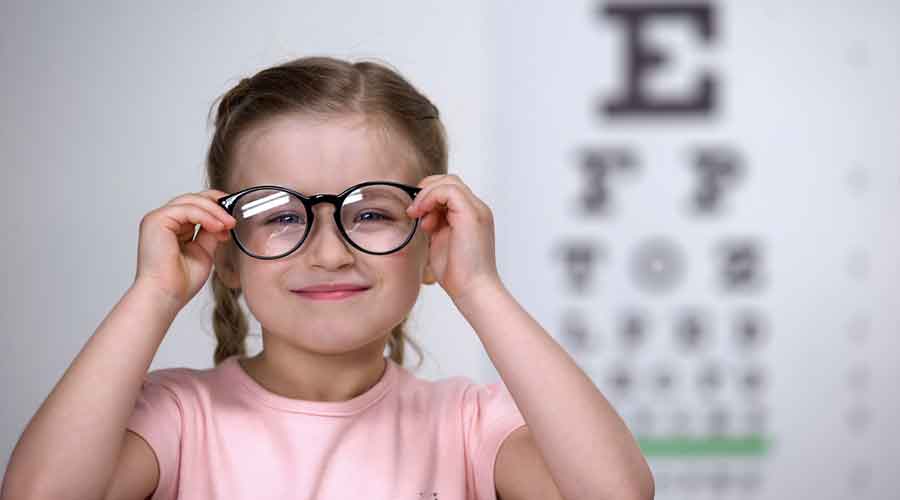Look and you shall see: a largely unrecognised epidemic of nearsightedness, or myopia, is afflicting children. People with myopia can see close-up objects clearly, like the words on a page. But their distance vision is blurry, and correction with glasses or contact lenses is likely to be needed for activities like seeing the blackboard clearly, cycling, driving or recognising faces down the block.
The growing incidence of myopia is related to changes in children’s behaviour, especially how little time they spend outdoors, often staring at screens indoors instead of enjoying activities illuminated by daylight. Gone are the days when children played outside. And the devastating pandemic may be making matters worse.
Susceptibility to myopia is determined by genetics and environment. Children with one or both nearsighted parents are more likely to become myopic. However, while genes take centuries to change, the prevalence of myopia in the US increased from 25 per cent in the early 1970s to nearly 42 per cent three decades later. And the rise is not limited to highly developed countries. The World Health Organization estimates that half the world’s population may be myopic by 2050.
Given that genes don’t change that quickly, environmental factors, especially children’s decreased exposure to outdoor light, are the likely cause of this rise. Consider factors that keep children indoors: emphasis on academic studies, irresistible attraction of electronic devices and safety concerns that demand supervision during outdoor play. These drastically limit the time youngsters spend outside, to the likely detriment of the clarity of their distance vision.
Recent research suggests that months of Covid-induced confinement may be hastening myopia’s progression among young children. A Canadian study that examined children’s physical activity, outdoor time, screen time and social media use during the lockdown in early 2020 found that 8-year-olds spent more than five hours a day on screens for leisure, in addition to screen time needed for schoolwork.
This report and a new study of school-aged children in China after five months of Covid-19 home confinement informed an editorial titled “2020 as the Year of Quarantine Myopia” in a January issue of JAMA Ophthalmology. Researchers from Emory University, Atlanta, US, the University of Michigan, Ann Arbor, US, and Tianjin Medical University Eye Hospital in Tianjin, China, described a substantial decline in the acuity among 1,23,535 elementary schoolchildren following school closures from last January to June. Compared to previous screenings, the ability to see distant objects clearly had fallen precipitously, especially among those aged 6-8. The children became far more myopic than expected. But a similarly dramatic drop among older children was not found.
“Given that the younger children were assigned fewer online tasks than the older ones, it is unlikely that the rapidly progressing myopia was caused by more intense screen time or near work,” the research team wrote. A lack of exposure to outdoor light is the more likely explanation.
As editorial writers from Erasmus University Medical Center in the Netherlands, suggested, “children may be more sensitive to myopic triggers from the environment”. An earlier study in Sydney also found that the younger ones who became myopic had spent more time on near work rather than being out in daylight.
Although many have long believed that excessive reading fosters nearsightedness, current thinking is that too much time spent indoors has the greater effect and likely accounts for any apparent association between close work or screen time and myopia.
Dr Neil M. Bressler, an ophthalmologist affiliated with Johns Hopkins, said that the high intensity of outdoor light has an important influence on the shape of the eye, which in turn affects whether images are seen clearly. To be in focus, light rays from an image have to converge on the retina. In myopic eyes, the convergence occurs in front of the retina, and a lens is needed to redirect incoming rays so that distant objects are in focus.
Most children are born slightly farsighted. The eyes are shaped like partly deflated balls, causing images to converge behind the retina. As they get older, the eyes elongate to form a sphere, permitting images to converge on the retina. If elongation fails to stop at some point, the eyes become more oval and images converge in front of the retina, the definition of myopia. Outdoor light stimulates the release of dopamine that may slow elongation of the eye, Bressler said.
Although the rise of myopia is happening worldwide, the epidemic is raging in east and Southeast Asia, where 80-90 per cent of high school children are myopic. And, those with myopia are more likely to develop sight-threatening complications later in life like cataracts, glaucoma and degeneration of the macula, the centre of the retina.
If the condition becomes extreme, Bressler said, it can be tough to correct. “The pandemic has put fuel on the fire,” he said, “but we don’t have a treatment yet.” Currently, the most effective preventive may be for young children to spend less time on screens and a lot more time outdoors.
NYTNS











